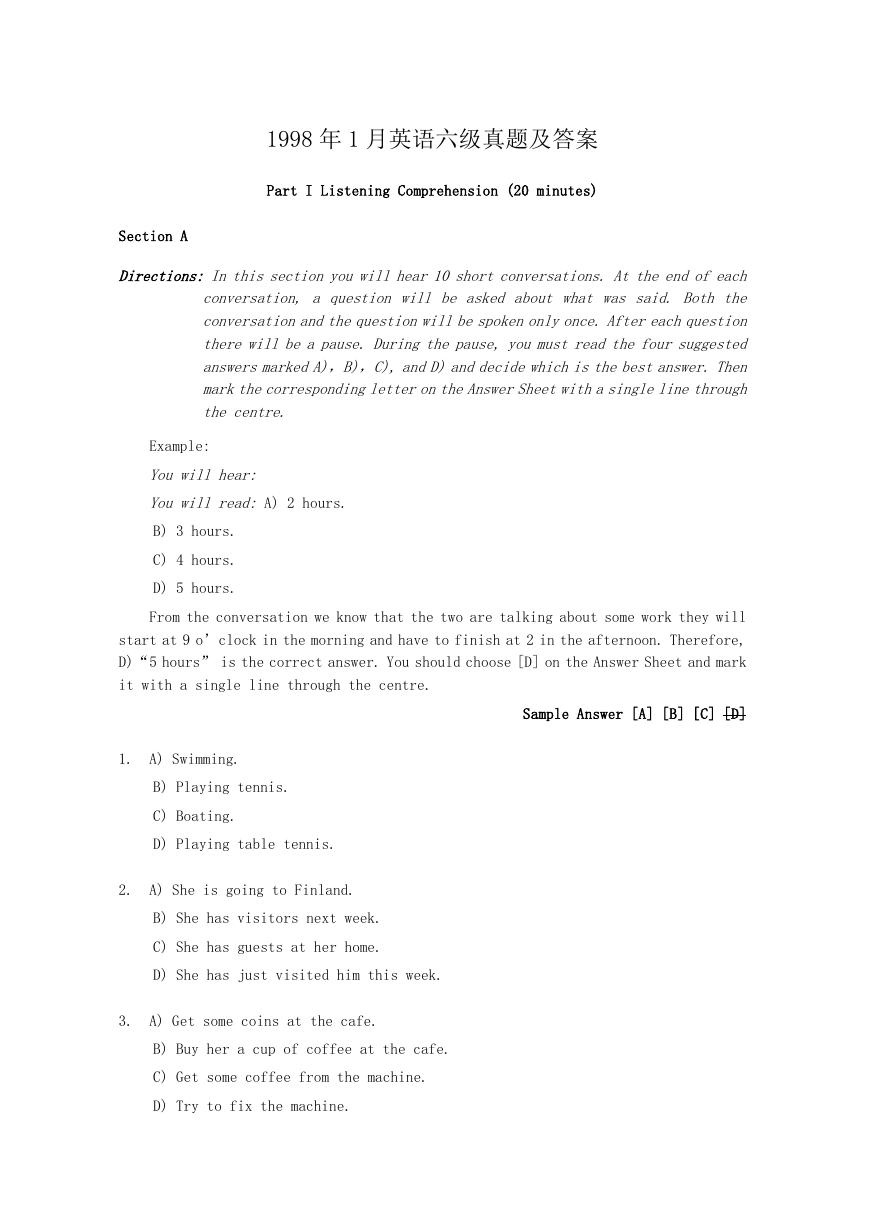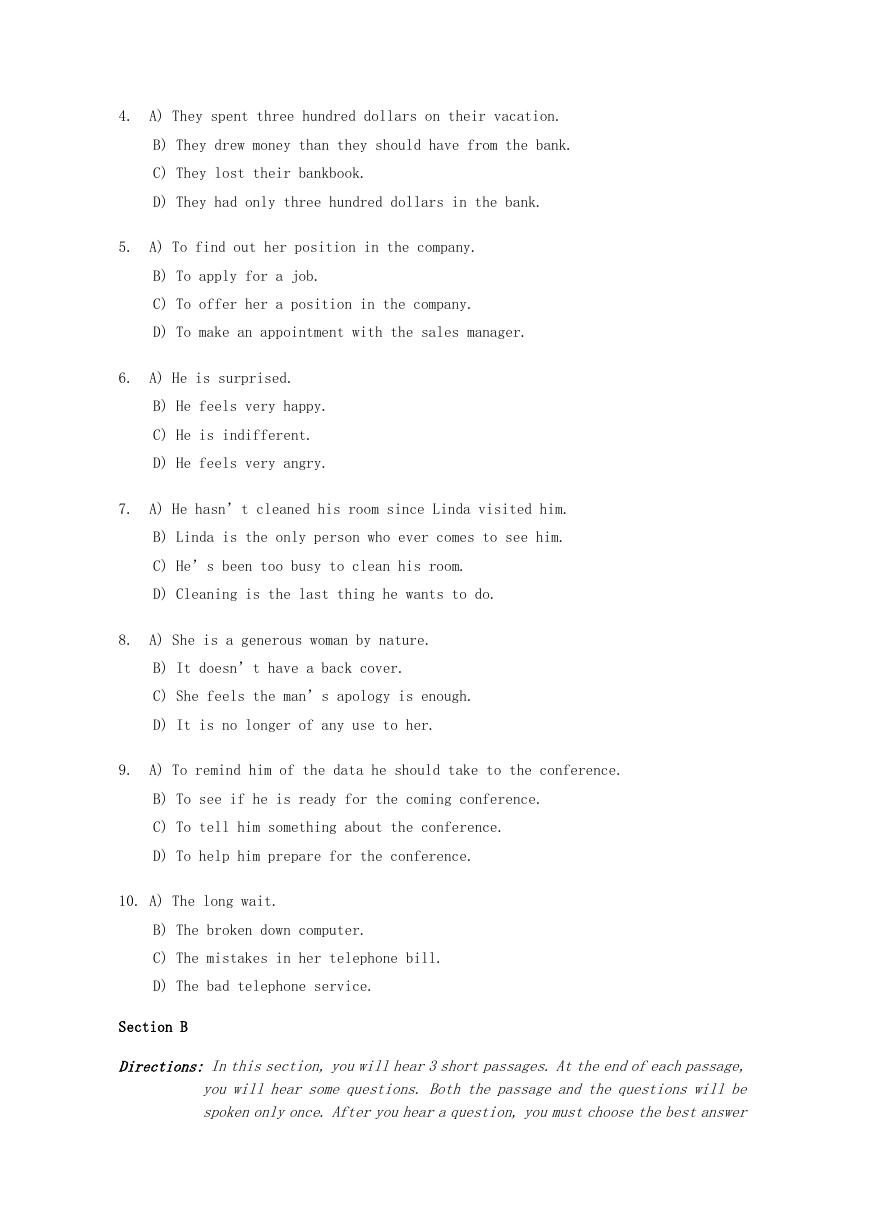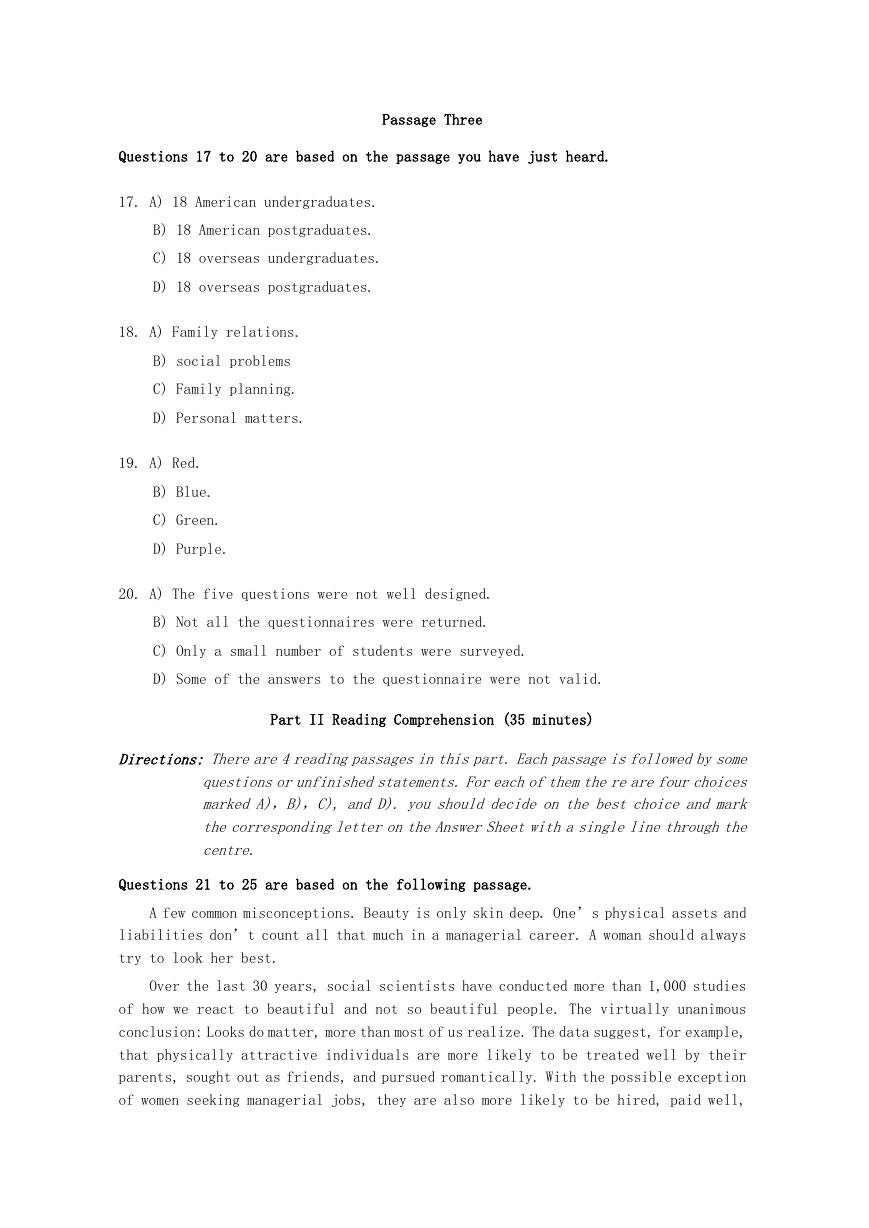1998 年 1 月英语六级真题及答案
Part I Listening Comprehension (20 minutes)
Section A
Directions: Inthissectionyou willhear10 shortconversations. At theendofeach
conversation, a question will be asked about what was said. Both the
conversationandthequestionwillbespokenonlyonce.Aftereachquestion
there will bea pause. Duringthe pause,youmust read thefoursuggested
answersmarkedA),B),C),andD)anddecidewhichisthebestanswer.Then
markthecorrespondingletterontheAnswerSheetwithasinglelinethrough
the centre.
Example:
You will hear:
You will read: A) 2 hours.
B) 3 hours.
C) 4 hours.
D) 5 hours.
From the conversation we know that the two are talking about some work they will
start at 9 o’clock in the morning and have to finish at 2 in the afternoon. Therefore,
D)“5 hours” is the correct answer. You should choose [D] on the Answer Sheet and mark
it with a single line through the centre.
Sample Answer [A] [B] [C] [D]
1.
A) Swimming.
B) Playing tennis.
C) Boating.
D) Playing table tennis.
2.
A) She is going to Finland.
B) She has visitors next week.
C) She has guests at her home.
D) She has just visited him this week.
3.
A) Get some coins at the cafe.
B) Buy her a cup of coffee at the cafe.
C) Get some coffee from the machine.
D) Try to fix the machine.
�
4.
A) They spent three hundred dollars on their vacation.
B) They drew money than they should have from the bank.
C) They lost their bankbook.
D) They had only three hundred dollars in the bank.
5.
A) To find out her position in the company.
B) To apply for a job.
C) To offer her a position in the company.
D) To make an appointment with the sales manager.
6.
A) He is surprised.
B) He feels very happy.
C) He is indifferent.
D) He feels very angry.
7.
A) He hasn’t cleaned his room since Linda visited him.
B) Linda is the only person who ever comes to see him.
C) He’s been too busy to clean his room.
D) Cleaning is the last thing he wants to do.
8.
A) She is a generous woman by nature.
B) It doesn’t have a back cover.
C) She feels the man’s apology is enough.
D) It is no longer of any use to her.
9.
A) To remind him of the data he should take to the conference.
B) To see if he is ready for the coming conference.
C) To tell him something about the conference.
D) To help him prepare for the conference.
10. A) The long wait.
B) The broken down computer.
C) The mistakes in her telephone bill.
D) The bad telephone service.
Section B
Directions: Inthissection,youwillhear3shortpassages.Attheendofeachpassage,
you will hear some questions. Both the passage and the questions will be
spokenonlyonce.Afteryouhearaquestion,youmustchoosethebestanswer
�
fromthefourchoicesmarkedA),B),C)andD).Thenmarkthecorresponding
letter on the Answer Sheet with a single line through the centre.
Questions 11 to 13 are based on the passage you have just heard.
Passage One
11. A) About 45 million.
B) About 50 million.
C) About 5.4 million.
D) About 4.5 million.
12. A) The actors and actresses are not paid for their performance.
B) The actors and actresses only perform in their own communities.
C) They exist only in small communities.
D) They only put on shows that are educational.
13. A) It provides them with the opportunity to watch performances for free.
B) It provides them with the opportunity to make friends.
C) It gives them the chance to do something creative.
D) It gives them a chance to enjoy modern art.
Questions 14 to 16 are based on the passage you have just heard.
Passage Two
14. A) They are usually more clever.
B) They get tired easily.
C) They are more likely to make minor mental errors.
D) They are more skillful in handling equipment.
15. A) It had its limitations.
B) Its results were regarded as final.
C) It was supported by the government.
D) It was not sound theoretically.
16. A) Their lack of concentration resulting from mental stress.
B) The lack of consideration for them in equipment design.
C) The probability of their getting excited easily.
D) Their slowness in responding.
�
Questions 17 to 20 are based on the passage you have just heard.
Passage Three
17. A) 18 American undergraduates.
B) 18 American postgraduates.
C) 18 overseas undergraduates.
D) 18 overseas postgraduates.
18. A) Family relations.
B) social problems
C) Family planning.
D) Personal matters.
19. A) Red.
B) Blue.
C) Green.
D) Purple.
20. A) The five questions were not well designed.
B) Not all the questionnaires were returned.
C) Only a small number of students were surveyed.
D) Some of the answers to the questionnaire were not valid.
Part II Reading Comprehension (35 minutes)
Directions: Thereare4readingpassagesinthispart.Eachpassageisfollowedbysome
questionsorunfinishedstatements.Foreachofthemtherearefourchoices
marked A),B),C), and D). you should decide on the best choice and mark
thecorrespondingletterontheAnswerSheetwithasinglelinethroughthe
centre.
Questions 21 to 25 are based on the following passage.
A few common misconceptions. Beauty is only skin deep. One’s physical assets and
liabilities don’t count all that much in a managerial career. A woman should always
try to look her best.
Over the last 30 years, social scientists have conducted more than 1,000 studies
of how we react to beautiful and not so beautiful people. The virtually unanimous
conclusion: Looks do matter, more than most of us realize. The data suggest, for example,
that physically attractive individuals are more likely to be treated well by their
parents, sought out as friends, and pursued romantically. With the possible exception
of women seeking managerial jobs, they are also more likely to be hired, paid well,
�
and promoted.
Un American, you say, unfair and extremely unbelievable? Once again, the scientists
have caught us mouthing pieties (虔诚) while acting just the contrary. Their typical
experiment works something like this. They give each member of a group-college students,
or teachers or corporate personnel mangers-a piece of paper relating an individual’s
accomplishments. Attached to the paper is a photograph. While the papers all say exactly
the same thing the pictures are different. Some show a strikingly attractive person,
some an average looking character, and some an unusually unattractive human being. Group
members are asked to rate the individual on certain attributes, anything from personal
warmth to the likelihood that he or she will be promoted.
Almost invariably, the better looking the person in the picture, the higher the
person is rated. In the phrase, borrowed from Sappho, that the social scientists use
to sum up the common perception, what is beautiful is good.
In business, however, good looks cut both ways for women, and deeper than for men.
A Utah State University professor, who is an authority on the subject, explains: In
terms of their careers, the impact of physical attractiveness on males is only modest.
But its potential impact on females can be tremendous, making it easier, for example,
for the more attractive to get jobs where they are in the public eye. On another note,
though, there is enough literature now for us to conclude that attractive women who
aspire (追求) to managerial positions do not get on as well as women who may be less
attractive.
21. According to the passage, people often wrongly believe that in pursuing a career
as a manager ________.
A) a person’s property or debts do not matter much
B) a person’s outward appearance is not a critical qualification
C) women should always dress fashionably
D) women should not only be attractive but also high minded
22. The result of research carried out by social scientists show that ________.
A) people do not realize the importance of looking one’s best
B) women in pursuit of managerial jobs are not likely to be paid well
C) good looking women aspire to managerial positions
D) attractive people generally have an advantage over those who are not
23. Experiments by scientists have shown that when people evaluate individuals on
certain attributes ________.
A) they observe the principle that beauty is only skin deep
B) they do not usually act according to the views they support
C) they give ordinary looking persons the lowest ratings
D) they tend to base their judgment on the individual’s accomplishments
�
24. “Good looks cut both ways for women” (Line 1, Para. 5) means that ________.
A) attractive women have tremendous potential impact on public jobs
B) good looking women always get the best of everything
C) being attractive is not always an advantage for women
D) attractive women do not do as well as unattractive women in managerial positions
25. It can be inferred from the passage that in the business world ________.
A) handsome men are not affected as much by their looks as attractive women are
B) physically attractive women who are in the public eye usually do quite well
C) physically attractive men and women who are in the public eye usually get along
quite well
D) good looks are important for women as they are for men
Questions 26 to 30 are based on the following passage:
Not content with its doubtful claim to produce cheap food for our own population,
the factory farming industry also argues that “hungry nations are benefiting from
advances made by the poultry(家禽) industry”. In fact, rather than helping the fight
against malnutrition (营养不良) in “hungry nations,” the spread of factory farming
has, inevitably aggravated the problem.
Large scale intensive meat and poultry production is a waste of food resources.
This is because more protein has to be fed to animals in the form of vegetable matter
than can ever be recovered in the form of meat. Much of the food value is lost in the
animal’s process of digestion and cell replacement. Neither, in the ca se of chicken,
can one eat feathers, blood, feet or head. In all, only about 44% of the live animal
fits to be eaten as meat.
This means one has to feed approximately 9—10 times as much food value to the animal
than one can consume from the carcass. As a system for feeding the hungry, the effects
can prove disastrous. At times of crisis, grain is the food of life.
Nevertheless, the huge increase in poultry production throughout Asia and Africa
continues. Normally British or US firms are involved. For instance, an American based
multinational company has this year announced its involvement in projects in several
African countries. Britain’s largest suppliers chickens, Ross Breeders, are also
involved in projects all over the world.
Because such trade is good for exports, Western governments encourage it. In 1979,
a firm in Bangladesh called Phoenix Poultry received a grant to set up a unit of 6,000
chickens and 18,000 laying hens. This almost doubled the number of poultry kept in the
country all at once.
But Bangladesh lacks capital, energy and food and has large numbers of unemployed.
Such chicken raising demands capital for building and machinery, extensive use of energy
resources for automation, and involves feeding chickens with potential famine relief
protein food. At present, one of Bangladesh’s main imports is food grains, because
�
the country is unable to grow enough food to feed its population. On what then can they
possibly feed the chicken?
26. In this passage the author argues that ________.
A) efficiency must be raised in the poultry industry
B) raising poultry can provide more protein than growing grain
C) factory farming will do more harm than good to developing countries
D) hungry nations may benefit from the development of the poultry industry
27. According to the author, in factory, vegetable food ________.
A) is easy for chickens to digest
B) is insufficient for the needs of poultry
C) is fully utilised in meat and egg production
D) is inefficiently converted into meat and eggs
28. Western governments encourage the poultry industry in Asia because they regard it
as an effective way to ________.
A) boost their own exports
B) alleviate malnutrition in Asian countries
C) create job opportunities in Asian countries
D) promote the exports of Asian countries
29. The word “carcass” (Line 2, Para. 3) most probably means “________”.
A) vegetables preserved for future use
B) the dead body of an animal ready to be cut into meat
C) expensive food that consumers can hardly afford
D) meat canned for future consumption
30. What the last paragraph tells us is the author’s ________.
A) detailed analysis of the ways of raising poultry in Bangladesh
B) great appreciation of the development of poultry industry in Bangladesh
C) critical view on the development of the poultry industry in Bangladesh
D) practical suggestion for the improvement of the poultry industry in Bangladesh
Questions 31 to 35 are based on the following passage.
We all have offensive breath at one time or another. In most cases, offensive breath
emanates from bacteria in the mouth, although there are other more causes.
Until a few years ago, the most doctors could do was to counsel patients with bad
breath about oral cleanliness. Now they are finding new ways to treat the usually curable
�
condition.
Bad breath can happen whenever the normal flow of saliva (唾液) slows. Our mouths
are full of bacteria feeding on protein in bits of food and shed tissue. The bacteria
emit evil smelling gases, the worst of which is hydrogen sulfide (硫 化物).
Mouth bacteria thrive in airless conditions. Oxygen rich saliva keeps their numbers
down. When we sleep, for example, the saliva stream slows, and sulfur producing bacteria
gain the upper hand, producing classic “morning breath”.
Alcohol hunger, too much talking, breathing through the mouth during exercise
anything that dries the mouth produces bad breath. So can stress, though it’s not
understood why. Some people’s breath turns sour every time they go on a job interview.
Saliva flow gradually slows with age, which explains why the elderly have more bad
breath trouble than younger people do. Babies, however, who make plenty of saliva and
whose mouths contain relatively few bacteria have characteristically sweet breath.
For most of us, the simple, dry mouth variety of bad breath is easily cured. Eating
or drinking starts saliva and sweeps away many of the bacteria. Breakfast often stops
morning breath.
Those with chronic dry mouth find that it helps to keep gum, hard candy, or a bottle
of water or juice around. Brushing the teeth wipes out dry mouth bad breath because
it clears away many of the offending bacteria.
Surprisingly, one thing that rarely works is mouthwash. The liquid can mask bad
breath odor with its own smell, but the effect lasts no more than an hour. Some
mouthwashes claim to kill the bacteria responsible for bad breath. The trouble is, they
don’t necessarily reach all offending germs. Most bacteria are well protected from
mouthwash under thick layers of mucus(粘液). If the mouthwash contains alcohol-as most
do-it can intensify the problem by drying out the mouth.
31. The phrase “emanate from” in Paragraph 1 most probably means “________”.
A) thrive on
B) account for
C) originate from
D) descend from
32. Which of the following is mentioned as one of the causes of bad breath?
A) Tooth trouble.
B) Sulfur rich food.
C) Too much exercise.
D) Mental strain.
33. According to the passage, alcohol has something to do with bad breath mainly because
________.
�
















 2023年江西萍乡中考道德与法治真题及答案.doc
2023年江西萍乡中考道德与法治真题及答案.doc 2012年重庆南川中考生物真题及答案.doc
2012年重庆南川中考生物真题及答案.doc 2013年江西师范大学地理学综合及文艺理论基础考研真题.doc
2013年江西师范大学地理学综合及文艺理论基础考研真题.doc 2020年四川甘孜小升初语文真题及答案I卷.doc
2020年四川甘孜小升初语文真题及答案I卷.doc 2020年注册岩土工程师专业基础考试真题及答案.doc
2020年注册岩土工程师专业基础考试真题及答案.doc 2023-2024学年福建省厦门市九年级上学期数学月考试题及答案.doc
2023-2024学年福建省厦门市九年级上学期数学月考试题及答案.doc 2021-2022学年辽宁省沈阳市大东区九年级上学期语文期末试题及答案.doc
2021-2022学年辽宁省沈阳市大东区九年级上学期语文期末试题及答案.doc 2022-2023学年北京东城区初三第一学期物理期末试卷及答案.doc
2022-2023学年北京东城区初三第一学期物理期末试卷及答案.doc 2018上半年江西教师资格初中地理学科知识与教学能力真题及答案.doc
2018上半年江西教师资格初中地理学科知识与教学能力真题及答案.doc 2012年河北国家公务员申论考试真题及答案-省级.doc
2012年河北国家公务员申论考试真题及答案-省级.doc 2020-2021学年江苏省扬州市江都区邵樊片九年级上学期数学第一次质量检测试题及答案.doc
2020-2021学年江苏省扬州市江都区邵樊片九年级上学期数学第一次质量检测试题及答案.doc 2022下半年黑龙江教师资格证中学综合素质真题及答案.doc
2022下半年黑龙江教师资格证中学综合素质真题及答案.doc